-
Posts
1,295 -
Joined
-
Last visited
Content Type
Profiles
Forums
Store
Help Articles
Posts posted by Chad
-
-
Nice haul. I'd rub the butts and do them in a slow oven rather than a crock pot.
Its going to be 85F with no A/C in the kitchen. Thats why I'm using the crockpots. I'm going to make them on Friday and pull them and reheat on Saturday. I've done them before in the crockpot ( the recipe I use is from the Gourmet slow cooker book) and they worked out well.
As a true Southerner it pains me to say this, but crock pot pulled pork actually works pretty well, especially with a decent rub or marinade. Are the butts bone-in or boneless? When I'm doing Carolina barbecue a bone-in shoulder yields about 45-50%, meaning that an 8lb shoulder, once the fat cap is removed, the meat is smoked and the collagen renders, and the bone is removed, ends up as 3.5-4lbs of pulled pork. A boneless shoulder isn't as flavorful but has a better yield.
Chad
-
"An Edge in the Kitchen" has received a starred review in Publishers Weekly!
An Edge in the Kitchen: The Ultimate Guide to Kitchen KnivesChad Ward. Morrow, $34.95 (240p) ISBN 9780061188480
Though humans have been using knives for about two and a half million years, you’ll be hard pressed to find as succinct and complete a collection of wisdom on the topic as this masterful volume from cook and writer Ward. He covers nearly everything, from construction and general knife care to proper storage and sharpening, giving cooks all the information they need. Detailed instructions on how to use the most common knives are bolstered with photos that thoroughly illustrate key techniques like dicing, chiffonade and julienne, as well as the lost art of cutting up a whole chicken....
See the whole Publishers Weekly review here (scroll down to the middle of the page).
Chad
edit: solecism
-
I own an Edge Pro system and use it with a fair amount of success on most of my kitchen knives. Over the past year, I've bought a couple of Japanese knives, which now seem as if they'd benefit from a true sharpening on the Edge Pro, rather than just a few swift passes on the ceramic "steel."
But, I'm worried that they're going to be, shall we say, not as sharp as they were when I first used them - that is, I'll screw them up, either the angle or the edge or both.
The first knife is a Tojio DO Gyuto and the other one is a MAC MSK-65 Santoko.
Any help would be greatly appreciated - and I mean in simple terms...are they double beveled, for example? How do I sharpen them - is each side sharpened to the same angle? Thanks for any and all advice...
Both the MAC and the Tojiro have a pretty standard double sided bevel, ryoba in Japanese. Neither, as far as I can tell, is asymmetrical in the way you'll find on some less westernized Japanese knives, so a standard 50/50 bevel will work just fine. In fact, I have or have had both of those knives and put a straight 50/50 bevel on them with ease.
If you set the Edge Pro to 15° you should be pretty close to the factory edge angle. You can either use the Magic Marker Trick to adjust the arm up or down to match the factory edge or standardize on the 15° mark for repeatability. Or you could take them even lower. I keep nearly all of my western-style Japanese knives at 10° or so without requiring undue maintenance.
The Tojiro in particular benefits from regular thinning. The outer jacket of soft stainless creeps down toward the harder core edge as the knife is sharpened over time. Thinning the shoulders back every once in a while will keep that from happening. A 10°/15° compound bevel would work nicely here, though it would take a little work with a coarse stone to jump right into. You could simply set the stone arm a little lower, use the coarse and medium stones to do some initial thinning, then reset the arm to 15° (or whatever you settle on) and sharpen as normal. Doing that each time will ensure that the edge doesn't get too thick and that the hard steel core is doing the cutting.
The softer jacket of the Tojiro scratches easily, as does the suminigashi cladding of the Shun. If that bothers you, tape off the sides of the blade with blue painter's tape. That will keep the swarf and stone grit from scratching the blade.
However you choose to approach it, don't worry about the Edge Pro not being up to the task. The Edge Pro stones are about as close to Japanese waterstones as it is possible to come. They work beautifully on Japanese knives.
-
Thanks, Mitch, for asking this. I have precisely the same issue: I feel confident about sharpening my western knives (mostly Wusthof, but some Henkels and Chicago Cutlery thrown in there) but very hesitant about my Ken Onion Shun chef's knife.
I've been at the Blade Show in Atlanta for the last several days and missed this. Sorry for the slow reply. I'll do a lengthier post tomorrow, but the short answer is that the Edge Pro Apex will work just fine with your Japanese knives. If you are worried about the swarf scratching the sides simply tape them with some blue painter's tape. The edge angles are going to be steeper than your western knives -- about 16° per side for the Ken Onion and 12-15° for the Tojiro and Mac. The Magic Marker Trick comes in handy here.
Chad
-
It's here! These are promotional copies for distribution at the Blade Show in Atlanta, mainly to companies that might want to do some sort of cross promotion. It is strangely emotional to finally see my book in finished form.
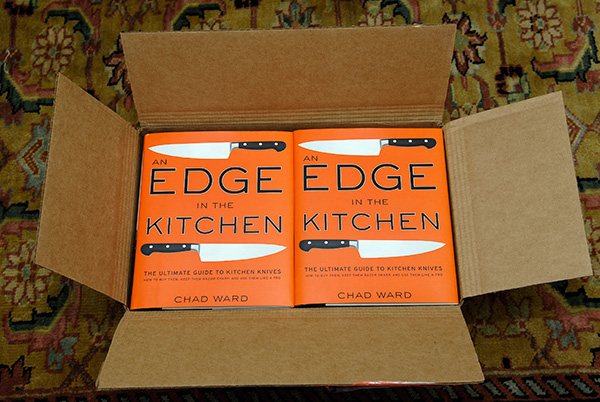
Then real life reasserts itself -- 30 seconds after opening the box my two years of work are nothing more than a cat bed.
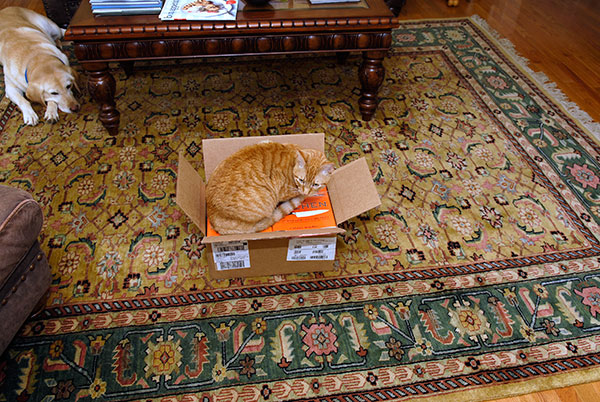
I get no respect

Chad
-
Thanks! I appreciate the encouraging words. I got a box of books dropped on my doorstep yesterday, promotional copies that I'm taking to the Blade Show in Atlanta. It's strangely emotional to finally see the book in finished form. I think we're doing the Q&A here some time in mid-June, after the book officially goes on sale.
In the "life just gets weirder" category, my publisher has requested that I do a couple of short videos to help promote the book. The catch, however, is that there is no budget. This is about as crude as it gets. Fellini it ain't.
Chad
-
Thanks! Just three weeks now until it hits the shelves. Then comes the fame, the fortune, my own small southsea island, the embarrassingly self-indulgent public behavior, the rehab -- I can hardly wait!
Chad
-
Thanks for the report! I'm eager to get to McCrady's soon. I'll probably manage a trip down there some time in August. I'm far from any sort of expert in these matters, but it seems that Sean Brock is just hitting his stride. It's a treat to watch, even from afar, someone having so much fun with his food.
Chad
-
Excellent! Thanks to both of you. Dave, I'll definitely check out micropundit's blog. That's exactly the sort of thing I was looking for.
The host hotel is balking at our VIP dinner on Saturday night so I'm trying to locate kitchen space & a meeting/dining room in the area. I realize it's an odd request, but if anyone knows of something like that near the Cobb Galleria, please let me know. It would be greatly appreciated.
Chad
-
Here's a more balance and reasoned article on the same topic:
The Revolution will not be Pasteurized: Inside the Raw Milk Underground
Chad
-
Well it actually has been for a long time. Lots of food handling (of food for sale) can be criminal and tragic too. I guess 'undercover milk buys' could be a little humorous in and of itself when we compare it to hard drugs, and dirty bomb weapon sales or something. But if someone got sick we would all jump those same officials who this time were doing their job too. I'm sure most everyone has had some kind of food poisoning and it ain't fun at a minimum.
I say good for them for catching the guy.
Excerpt from link below:
"Here are a few examples of outbreaks that have been reported since 2000:2001: Outbreak of Campylobacter jejuni infections from drinking “raw” or unpasteurized milk.
2003: Outbreak of Listeria monocytogenes infections from eating unpasteurized queso fresco (a Mexican-style soft cheese)
2003: Outbreak of Salmonella infections from eating unpasteurized queso fresco.
2004: Outbreak of E. coli.O157 infections from eating unpasteurized queso fresco
There's been deaths in the past from contamination too. There was one case (in the North East if memory serves) where the milk was actually pasteurized then some bad mojo got in the lids or something and it was real bad news for a few folks.
What the article fails to mention is that every instance of salmonella and e. coli outbreaks involving cheese have been from pasteurized milk cheeses. Raw milk is not the culprit. Bad manufacturing and sanitation practices are. Those figures are a red herring used to justify an unreasonable ban.
Chad
-
I'll be in Atlanta for the Blade show (cutlery industry trade show) May 30 through June 1. That's Friday through Sunday. I believe I'm cooking for a VIP dinner on Saturday night but what shouldn't I miss while I'm in town? The show is at the Cobb Galleria & Renaissance Waverly, so close by would be a plus but I'm willing to drive a little for something special. I haven't been to Atlanta for years, so catch me up!
Thanks!
Chad
-
What a great travelogue (porkologue?)! I've enjoyed this immensely. Thanks so much, Viva. I'm saddened that I live here and haven't tried as many places as you managed in a short time.
Chad
-
Hi, folks. I promise I'll keep the shameless shilling to a minimum, but if anyone is curious an excerpt from the Introduction is up on chadwrites.com/An Edge in the Kitchen. The Table of Contents is also available if you'd like to take a look.
Looks like I'll be doing a Q&A here on eGullet (yay!), which should be a lot of fun. I'm looking forward to it, so start getting your questions ready.
Take care,
Chad
-
Yep, everything is on track. The publishing process just moves very, very slowly. The advance reader's copies are out to blurb prospects -- you know, the people who say things like "I laughed, I cried, it became a part of me" on the back cover. Final corrections are done (I think) and my Amazon link is live, though the cover isn't up yet.
Final specs:
- 224 pages plus a 48-page color insert
- 7-3/8" x 9-1/4" hardback
- B&W photos & illustrations throughout
- $34.95 list, but Amazon has it for $23.07. So much for my 2nd home on the Riviera
- Official publication date is June 10. I hope it'll be available a little before that.
Here's the jacket flap copy, which I think turned out very well:
Why are most of us so woefully uninformed about our kitchen knives? We are intimidated by our knives when they are sharp, annoyed by them when they are dull, and quietly ashamed that we don’t know how to use them with any competence. For a species that has been using knives for nearly as long as we have been walking upright, that's a serious problem. An Edge in the Kitchen is the solution – an intelligent and delightful debunking of the mysteries of kitchen knives, once and for all. If you can stack blocks you can cut restaurant quality diced vegetables. If you can fold a paper airplane you can sharpen your knives better than many professionals.Veteran cook Chad Ward provides an in-depth guide the most important tool in the kitchen, including choosing the best kitchen knives in your price range, practical tutorials on knife skills, a step-by-step section on sharpening, and more — all illustrated with beautiful photographs throughout. Along the way you will discover what a cow sword is, and why you might want one; why chefs are abandoning their heavy German knives in droves; and why the Claw and the Pinch, strange as they may sound, are in fact the best way to make precision vegetable cuts with speed and style.
An Edge in the Kitchen is the one-and-only guide to the most important tool in the kitchen.
Chad Ward has been a writer and cook for more than 20 years. To date, more than 300,000 people have taken Chad’s online knife sharpening class on eGullet.org. His writing has been published in publications ranging from Best Food Writing to Aviation International News. He lives in North Carolina.
Thanks for the interest and support, folks. I really appreciate it.
Chad
- 224 pages plus a 48-page color insert
-
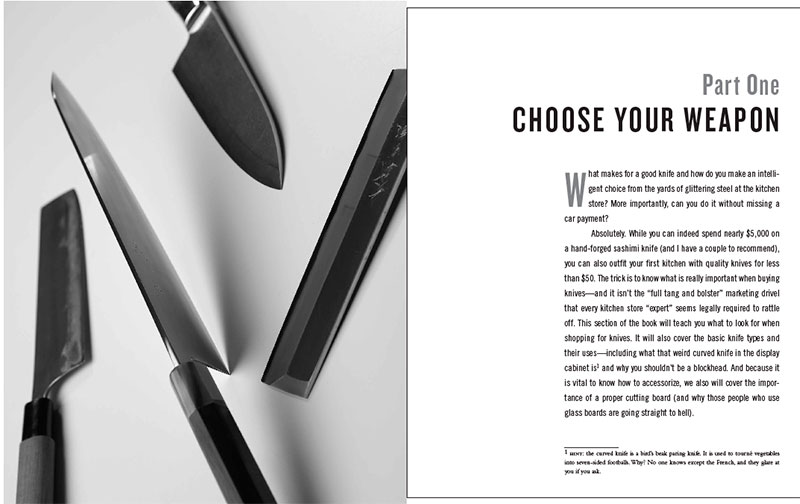
I don't know about advance orders, but the book should hit the shelves about mid-May, as I understand it, so it should be orderable (is that even a word?) from Amazon and the like probably around Christmas.
Had to add one more photo just because it's such a cool shot.
Chad
-
Thanks!
I know that in addition to the Hertzmann book out now (the illustrated one) there's going to be another knife book out about the same time. Yikes. I can only hope that large, friendly pictures and a little humor put mine out front. Keep your fingers crossed.
Chad
-
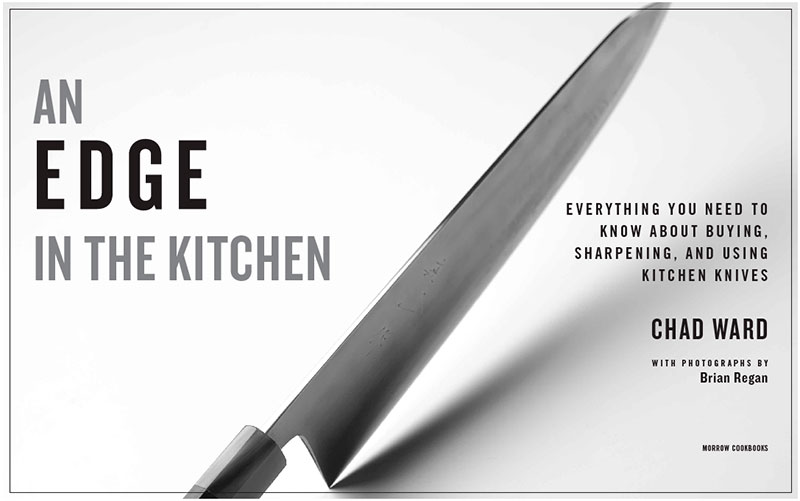






I just got sample pages today. This is what the title page will look like. I think it's pretty f'ing sexy.
Chad
-
<raises hand>
I don't. I use more Japanese-style push cuts. It's more precise. Rocking is great if you've got a ton o' prep to bang out for a busy restaurant, but for a serious home cook who doesn't have the time pressure of a prep cook or for a chef going for high level presentation, push cuts make more sense.
Chad
-
I have had excellent service from Epicurean Edge in Kirkland, WA. Last year sharpening my Japanese knives was $1.65 per inch.
I've since then bought the Edge Pro system and am very pleased that I did.
Doh! Thanks for bringing them up, Robert. I can't believe I forgot Dan O'Malley & the folks at Epicurean Edge. They do really nice work. They also can re-handle knives if you have a basically sound knife with a cracked or broken handle (or just want something cool).
Good choice on the Edge Pro. I love mine.
Chad
-
Chad - would it be correct to infer from your post that 'true Damascus' is very rare indeed, and that the vast majority of product described as 'Damascus' should be more accurately described as 'suminagashi"?
And that all such decoration needs especially considerate treatment?
It's certainly rare in kitchen knives. There is, however, a thriving community of custom knife makers who either forge Damascus for daggers, hunters and collectible knives or purchase the ready made steel from somebody like Devin Thomas, the modern master of pattern welded Damascus steel. Click on the "Products" link to see some of the amazing patterns.
ABS Mastersmith Kevin Cashen is one of the more notable knife makers who forges his own pattern welded damascus.
Like the Ken Onion knife, almost all laminated blades will have softer steel on the sides. In theory this gives the harder (and more brittle) core some protection and needed flexibility. It also leaves the sides vulnerable to scratches and scuffs. For folks who own Shun, Hattori or Ryusen knives that have become scratched, Dave Martell at D&R Sharpening/Japanese Knife Sharpening offers a polish and re-etching service that can return a scratched or worn suminagashi/damascus surface to better than new condition.
Chad
-
One thing to note: the suminagashi (faux Damascus) cladding on the outside is very soft. When you use the Edge Pro, tape the sides of the blade with blue painter's tape to keep the grit and swarf from scratching up the pattern.
Chad, I am not familiar with faux Damascus. Do all Shun knives feature this?
Nope. The Shun Classic line does as does the Hattori HD line and the Ryusen standard knives. All of these knives have an inner core of VG-10 steel covered with an outer jacket made up of 16 layers of softer stainless steel that have been folded and welded into a lovely pattern of swirls and waves called suminigashi or “ink pattern” because it resembles an ancient Japanese paper decorating technique of the same name where drops of ink were carefully dripped into still water and blown into swirls. It is primarily decorative.
True Damascus steel was part of a middle eastern sword making technique from the 1100s. Today's Damascus is generally pattern welded steel -- two or more types of steel forge welded together, drawn out and folded and refolded into hundreds of layers. The blade is etched to bring out the pattern. The layered steel actually makes up the whole thickness of the blade rather than being a decorative jacket like the laminated suminagashi knives.
This is a 10" Shun Classic chef's knife.

This is a 270mm Hattori HD gyuto with a custom handle.
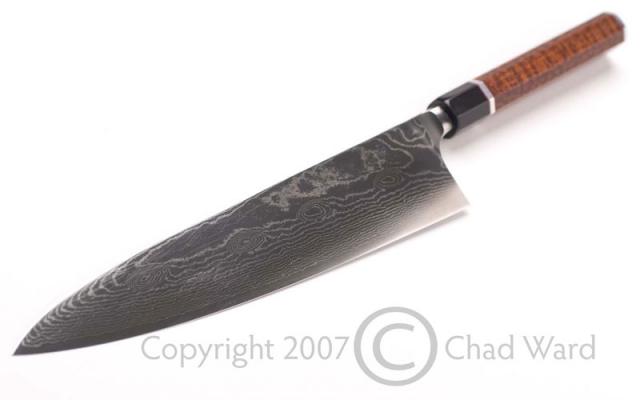
Both of them have decorative suminagashi jackets. Marketing folks call it Damascus because more people are familiar with that term.
This is a real Damascus (at least the way we define it today) custom Murray Carter knife.
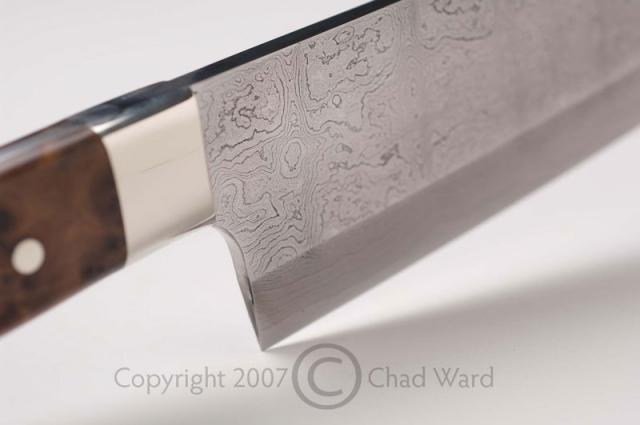
To bring this back to the original topic, the Ken Onion knife has the softer suminagashi jacket. It scuffs very easily, so when sharpening it's best to tape up the sides of the blade so they don't get scratched.
Chad
-
And finally, Is there a mail-in knife sharpening service that you recommend?
I just have a moment, so I'll start with this one. Full answer tomorrow.
Yes! There is a great mail order sharpening service. In fact, there are a couple. One of the best in the business is eGullet member Dave Martell at D&R Sharpening Solutions outside of Philadelphia. His prices are reasonable and his sharpening service is exemplary. He even has an upgraded service for tricky Japanese knives or for chefs who are into extreme edge angles and polish levels. Dave knows his stuff and is a hell of a nice guy.
If Dave is full up or if you are closer to Washington, Bob Kramer at Kramer Knives is excellent. He is first and foremost a knifemaker of rare skill but he still does sharpening, too.
1SharpKnife in Arizona is also a good resource. I haven't tested his mail order sharpening services but have heard very good things. Curtis is also a great source for Edge Pro Apex sharpening rigs, extra stones and other sharpening gear.
Chad
-
. . . When I was in Sur la Table a few weeks ago, the salesperson informed me that I could not use my Chef's Choice on it, but that Shun does sell an electric sharpener, specifically for these knives.
Do I take it correctly, Chad, from your comments above that the electric sharpener, even the one made by Shun, is a bad idea?
You can use your Chef's Choice on the Shun knives, you'll just change the edge angle to something significantly more obtuse and less useful. The Shuns have 16-degree-per-side angles (32 degree included angle). The Chef's Choice sharpeners finish with a 25-degree-per-side angle (50 degree included angle). Chef's Choice does make an electric sharpener (model# 316) that is set up for the more acute angles you find on Japanese knives.
I have several electric sharpeners in my office that I tested for my book, but I hadn't seen the Shun sharpener until just now. It must be new. Every electric sharpener has similar flaws. The first stage removes metal at an alarming rate. They should come with a password protected lock that can only be removed when you can verify that you have read the owner's manual at least twice and swear not to use the first stage except in extreme emergencies. The second and third stages (if available) don't do quite as much damage, but leave the edge much coarser and more obtuse than it should be. You end up with an edge that feels very aggressive but doesn't last very long, necessitating another trip through the whirling stones of death. Argh. And if a knife has a bolster that goes all the way to the heel (as many traditional German and French styles do), an electric sharpener will, over time, hollow out a small half-moon shaped scoop just in front of the heel. That scoop, called a swale, keeps the back end of the knife from contacting the cutting board cleanly, reducing the effectiveness of your knife. The only way to get rid of it is to have a professional sharpener grind the rest of the edge down to the level of the swale, greatly reducing the life span of your knife.
So, no, I'm not a big fan of electric sharpeners. Chef's Choice does have one model, the 120, that I do like. It has a powered strop that can keep your edges at a fairly high performance level for a very long time without having to resharpen.
Chad



Calipoutine Scrambles to go Catering
in Cooking
Posted
Hmmm, if you get 50% yield on 25lbs of shoulder/butt (same cut unless you got "picnic shoulder") that's 12.5lbs of pulled pork, which works out to 200oz or 50 4oz portions. Served on buns with coleslaw and sides, that will probably be just about perfect. You may need to take a little extra time pulling the pork to make sure you get every scrap of usable meat, but you should be fine.
The loins are going to cook up a little differently. Not only are they leaner, they don't have the collagen and connective tissue that gives pulled pork its distinctive "juiciness" and mouthfeel. Personally, I'd roast the loins and offer them sliced thin as an alternative or addition to the pulled pork. With that said, however, if time and space are issues, they'll be just fine in the slow cookers, too.
Thanks for starting this. I'm having fun following along with your adventures.
Chad